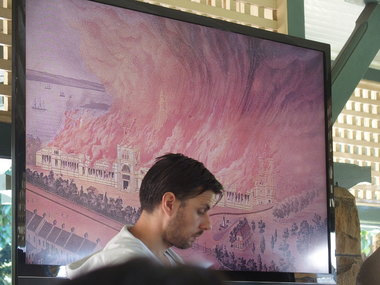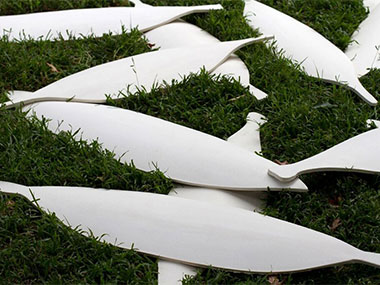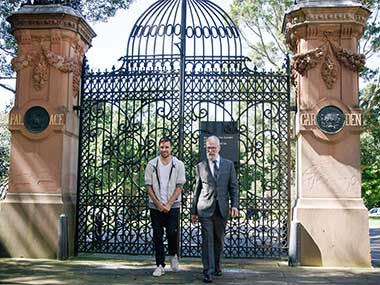Skin and Bones in the Gardens

Artist Jonathan Jones stands before the painting that captures the conflagration which destroyed Sydney's Garden Palace
Posted by Jeremy Eccles | 21.04.16
Dates:
17.09.16
: 03.10.16
Location: Royal Botanical Gardens, Macquarie Street, Sydney
For the 32nd Kaldor Public Art Project, Sydney-based artist Jonathan Jones will present 'barrangal dyara' (skin and bones' ), marking the first Kaldor Public Art Project presented with an Australian Aboriginal artist and one of the largest and most significant to date.
This ambitious project will transform Sydney’s Royal Botanic Garden from 17 September until 3 October 2016. A vast sculptural installation across 20,000 square-metres of the Garden incorporating a native kangaroo grassland and thousands of ceramic shields will blanket the site, which will be activated and enlivened by presentations of Aboriginal language, performances, talks, special events and workshops each day. A major component of the Royal Botanic Garden’s Bicentenary Celebrations, 'barrangal dyara' (skin and bones) is presented free to the public, and enormous numbers of visitors to the site over 17 days are anticipated.
First conceived by the Wiradjuri/Kamilaroi artist as an entrant in Kaldor Public Art Projects’ 45th anniversary project for Australian artists, YOUR VERY GOOD IDEA, Jones’ proposal to create a large-scale, temporary art project for Sydney was selected from 160 ambitious applications by an international panel of curators and museum directors and given a budget of $350,000.
barrangal dyara (skin and bones) will recall the 19th century Garden Palace building where it originally stood in the Garden between 1879 and 1882, before it devastatingly burnt to the ground, just like its inspiration, London's Crystal Palace. The conflagration took with it countless Aboriginal objects collected by the Australian Museum along the colonial frontier – virtually its complete Indigenous collection. The project is artist Jonathan Jones’ response to the immense loss felt throughout Australia due to the destruction of these culturally significant items. It represents an effort to commence a healing process and a celebration of the survival of the world’s oldest living culture despite this traumatic event.
In 1879 the International Exhibition, for which the Garden Palace was created, promoted the identity and values of a British colony actively redefining itself - moving away from its convict past to present the image of a prosperous, developing settlement. This Spring, Jones’ project on the site of the lost Palace, attempts to excavate this forgotten history. He will re-tell local history from an Aboriginal perspective, giving new light to a moment in our shared history and speaking to cultural tensions still present in contemporary Australia.
Jones was a little more specific when the project was announced in September 2014: He said he was seeking to “contrast the proud displays of wool, wheat and gold which gave the Colony its status with the ethnographic collections of Indigenous object from NSW which were displayed “to promote the idea of 'primitive' man as commodity as well as lauding the superiority of the colonists and legitimising the genocide and dispossession of Aboriginal people from their lands”.
The 32nd Kaldor Public Art Project connects directly with many Aboriginal communities in Sydney and south-east Australia to develop key elements of the work, collaborating to reframe Australian history for both Indigenous and non-Indigenous Australians. The artwork takes its name, barrangal dyara, meaning ‘skin and bones’, from the local Garrigal language, on whose country the project will take place with approval from that community.
Thousands of shields will echo the masses of rubble left over after the fire, raising the bones of the Garden Palace for a contemporary audience. Each shield takes its shape from one of four shield designs from Aboriginal nations in the south-east of Australia. The ceramic forms, created through the medium of fire, symbolically invert the flammability of the wooden and bark Aboriginal objects in the 1882 blaze. Jones references his Kamilaroi and Wiradjuri heritage through the native grassland element of the installation, speaking to the traditional management of crops such as kangaroo and wallaby grass and native millet that's increasingly being recognised in books such as Bill Gammage's 'The Biggest Estate on Earth', Bruce Pascoe's 'Dark Emu' and John Newton's 'The Oldest Foods on Earth'. Fire was an important tool in the development of these grasslands and ‘burning off’ was an essential process, creating rebirth and renewal.
Key parts of the project have been developed in consultation with Gadigal elders, Uncle ‘Chicka’ Madden and Uncle Allen Madden, who will continue to be consulted, and Kaldor Public Art Projects has established an Aboriginal Advisory Group to guide the project.
Jones and Kaldor Public Art Projects are thrilled to be partnering with the Royal Botanic Gardens to realise this work. In addition, several cultural institutions with close historic ties to the Garden Palace will collaborate to realise various elements of the event. Collaborators and contributors include: the Australian Museum; the State Library of NSW; Sydney Conservatorium of Music; the Museum of Arts and Applied Sciences; Art Gallery of New South Wales; Sydney Living Museums and Bangarra Dance Theatre.
Between May and August, a series of three symposia will act as ‘spot fires’ that will ‘fan the flame’ of ideas circulating around barrangal dyara (skin and bones). Kaldor Public Art Projects, Jonathan Jones and academic Ross Gibson, in partnership with the State Library of New South Wales, the Art Gallery of New South Wales and the Australian Museum, will stage three days of presentations, conversations and performances to help us examine, evoke and in various ways re-animate the Palace site and its complex history.
Sponsorship and philanthropy associated with the project is multifarious: the Commonwealth Bank, PriceWaterhouseCoopers, Bloomberg Philanthropies, and long-term Kaldor Public Art Projects supporters The Balnaves Foundation, The Naomi Milgrom Foundation, and The Nelson Meers Foundation have all come to the party. Government partners are Arts NSW, The City of Sydney and the Australian Government through the Catalyst Australian Arts and Culture Fund, the Australia Council for the Arts and the Indigenous Languages and Arts Program.
SYMPOSIA DATES
Spot Fire Symposium 1: Landscape and language, Saturday 7 May, State Library of New South Wales
Spot Fire Symposium 2: Spectacle, manifestation, performance Saturday 16 July, Art Gallery of New South Wales
Spot Fire Symposium 3: Loss and resilience Saturday 6 August, Australian Museum
URL: http://kaldorartprojects.org.au/
Share this:
»  del.icio.us
»
del.icio.us
»  Digg it
»
Digg it
»  reddit
»
reddit
»  Google
»
Google
»  StumbleUpon
»
StumbleUpon
»  Technorati
»
Technorati
»  Facebook
Facebook
Contact Details

Some of the protoype Gamilaroi ceramic shields which will form part of the 'barrangal dyara' (skin and bones) artwork to be installed in September in Sydney

Jonathan Jones and John Kaldor step it out in front of the 200 year old Royal Botanical Gardens in Sydney
Further Research
Artists: Jonathan Jones
News Tags: Garden Palace | Jeremy Eccles | John Kaldor | Jonathan Jones | Kaldor Art Projects | Sydney Botanical Gardens
News Categories: Australia | Blog | Exhibition | Feature | Industry | News
Exhibition Archive
- 10.10.17 | TARNANTHI 2017
- 11.08.17 | Natsiaas 2017
- 20.07.17 | APY ART DOMINATES THE WYNNE
- 17.07.17 | Anangu Artist Wins $100,000 Prize
- 14.07.17 | The End of AAMU
- 11.07.17 | ART ACROSS THE COUNTRY
- 11.07.17 | TARNANTHI IN OCTOBER
- 05.07.17 | TJUNGUṈUTJA - from having come together
- 13.06.17 | Ghost-Nets Straddle the World
- 07.06.17 | Grayson Perry Going Indigenous?
- 05.06.17 | Barks Bigger than Ben Hur
- 27.05.17 | NGA QUINQUENNIAL 2017
- 21.05.17 | Blak Douglas Finds Home at the NGA
- 21.05.17 | BRIAN ROBINSON WINS HAZELHURST WOP
- 18.05.17 | PARRTJIMA 2.0
Advertising

